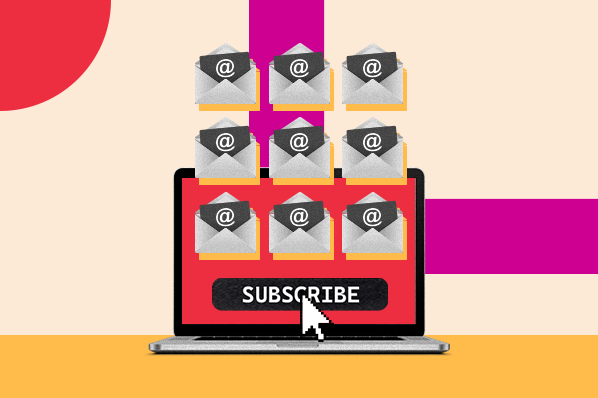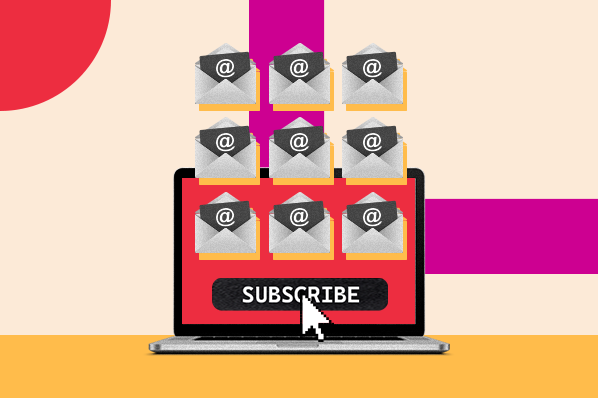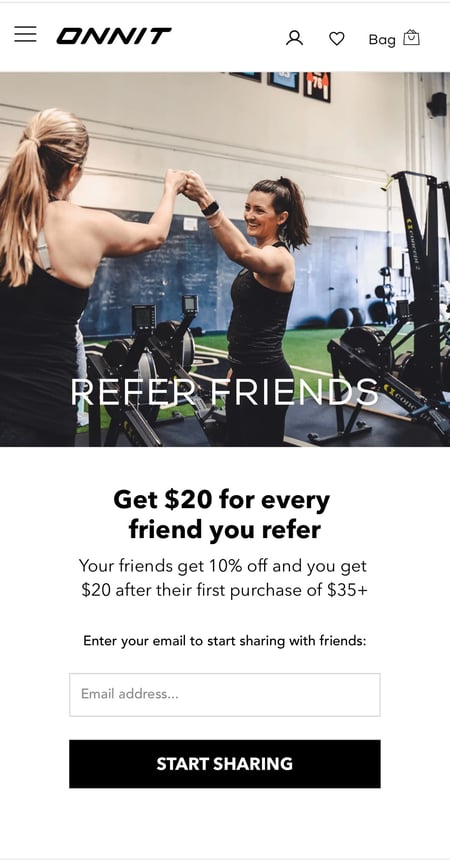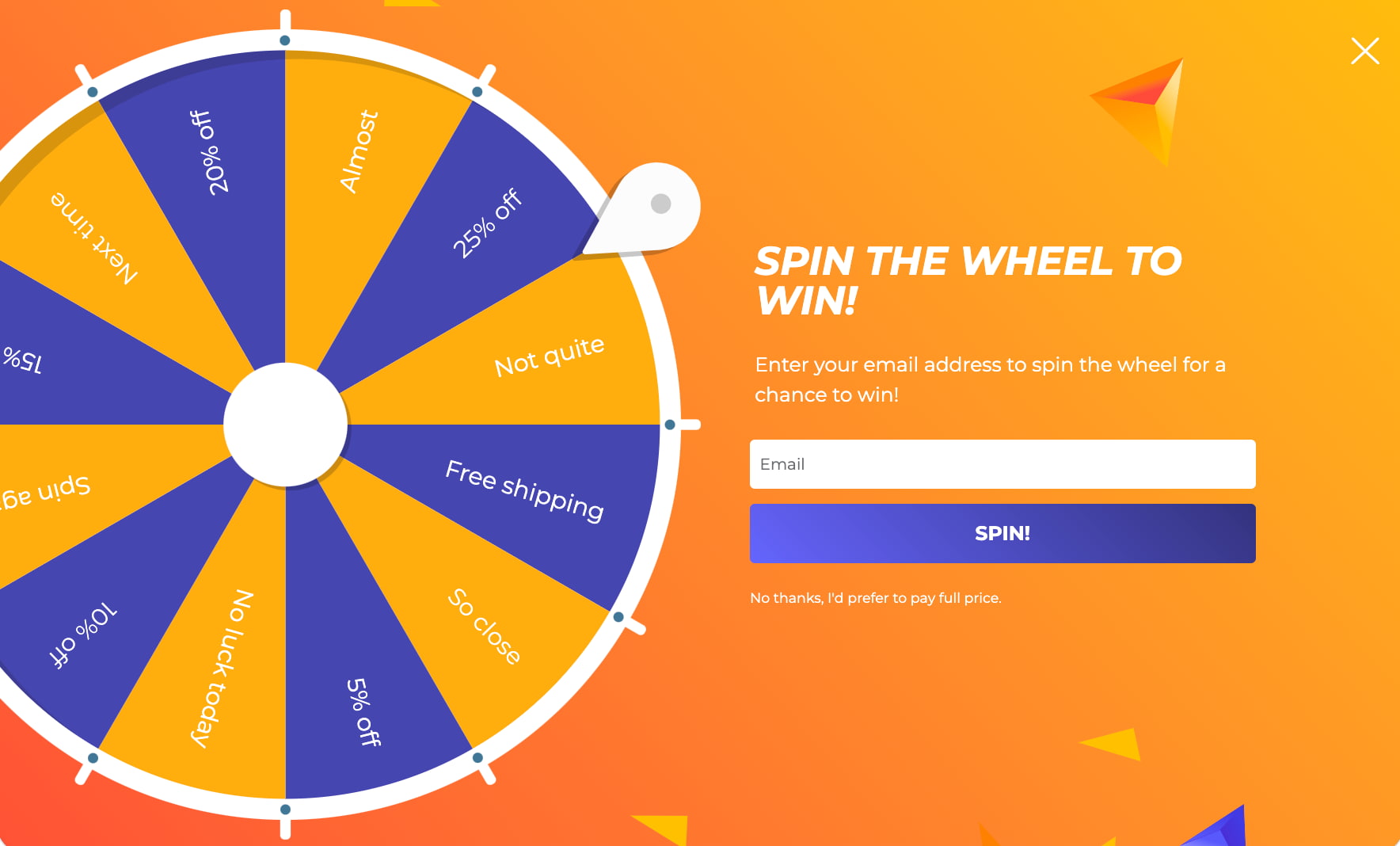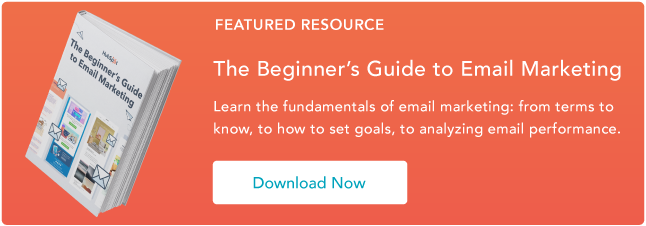It costs more to attract a new customer than to keep an existing one.
It costs more to attract a new customer than to keep an existing one.
Focusing on customer retention is a valuable long-term solution for increased revenue and sustainable growth, and building an email list will help you reach those goals. ![→ Download Now: The Beginner's Guide to Email Marketing [Free Ebook]](https://no-cache.hubspot.com/cta/default/53/53e8428a-29a5-4225-a6ea-bca8ef991c19.png)
Cultivating customer loyalty is not easy, but it is possible by continuing to offer valuable content. While there are many ways to do this, email marketing is one of the most powerful ways to reach your target audience — if done correctly.
We’ll explore:
Qualities of a Great Email List
Before setting out to build an email list, we’ll need to go over some best practices first. Here are a few qualities to shoot for creating and maintaining an email list. The list should be:
1. Permission-Based
First and foremost, your email list should consist of people who have willingly and explicitly given consent to receive emails from you. Never buy an email list. No one likes spam, so keeping with this basic principle ensures you’re following marketing compliance guidelines and maintain a positive reputation.
2. Accurate and Current
Email addresses should be valid and accurate. To make this happen, commit to regularly removing invalid or bounced email addresses to maintain deliverability and engagement rates.
3. Relevant to Your Audience
Subscribers should have a genuine interest in your products, services, or content. For best results, they should match your target audience who are most likely to engage with the emails you send out.
4. Contain Engaged Users
The best email lists have subscribers that actively engage with the sender — consistently opening, clicking, and responding to emails. These are the subscribers that are most likely to convert, share your content, and provide the most value over time.
5. Easily Segmented
A good email list should also lend itself well to segmentation. These segments can be based on demographics, interests, past purchases, engagement levels, or other criteria. This enables you to send targeted and personalized emails that will resonate with specific segments of your audience.
6. Growing
Your email list should see consistent growth. Try implementing strategies to attract new subscribers, such as lead magnets, social media promotions, or collaborations with other businesses.
7. Easy to Unsubscribe
While you may think it is counterintuitive to allow people to easily opt out of your emails, it’s actually good business. Think about it. No one wants to have to struggle and become frustrated trying to figure out how to unsubscribe from correspondence. Keep your unsubscribe button transparent and easy to locate.
Focus on building an email list that includes relevant and engaged subscribers, and regularly refine your email marketing strategies to improve your list’s quality over time.
How to Build an Email List From Scratch
1. Create a pop-up CTA (call-to-action) for each page of your site.
A pop-up might sound initially bothersome, but I’m not talking about those early 2000s pop-up that pop-up’s that promised you’d “Become a Model NOW”.
Instead, I’m talking about timed pop-up ads, or onsite retargeting. After a user spends a certain amount of time on your page, she can receive a pop-up relevant to the content on that page, or to her behavior. Examples include exit pop-ups, which appear when a user tries to leave the page, or scroll pop-ups, which appear after the user scrolls a certain percentage down the page.
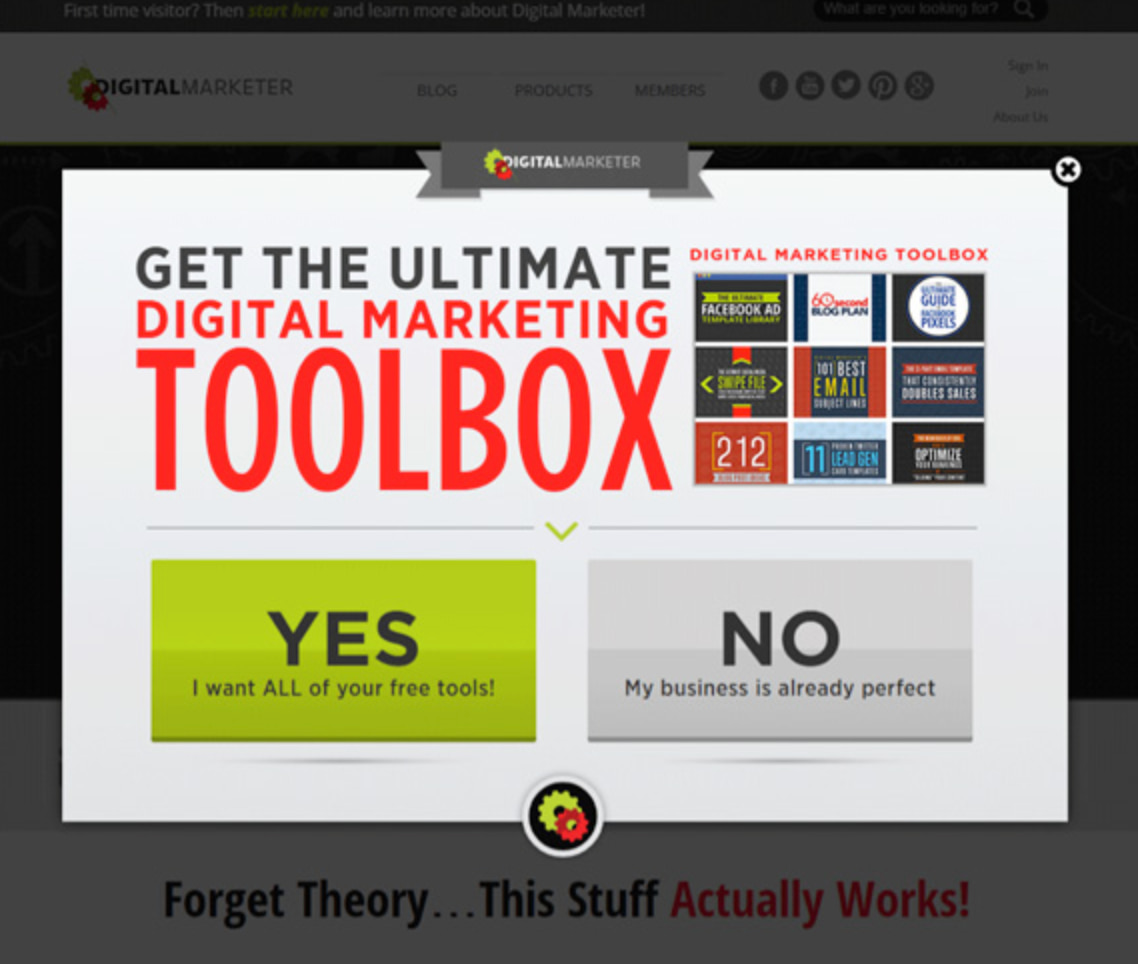
Digital Marketer conducted a case study to determine the value of onsite retargeting. For one experiment in particular, Digital Marketer introduced a pop-up ad to returning visitors only, which appeared after a visitor spent 15 seconds on their site:
Digital Marketer ensured this pop-up didn’t show up if someone came to the page from the newsletter (in which case, they were already signed up), and also didn’t pop-up on a sales page (which could interrupt someone’s purchasing decision).
As you can see, Digital Marketer also took the time to offer meaningful content, a digital marketing toolbox, in their pop-up ad. With an impressive offer, your pop-up is no longer obtrusive or interruptive — it’s simply helpful.
Ultimately, their campaign generated 2,689 leads in two weeks, and increased their average time on page by 54%. Pop-ups aren’t always gimmicky, and if done right, you’re able to appeal to your visitor with quality content when and where they need it.
2. Create a personalized CTA for each blog or landing page.
HubSpot has found personalized calls-to-action have a 42% higher view-to-submission rate than calls-to-action that are the same for all visitors — that’s almost double your potential email subscribers.
It makes sense: the people who visit your blog post or web page are looking for something specific, so your CTA needs to meet those unique needs. For instance, if you’ve got a ton of traffic visiting your “List-Building Strategy” blog article, why not entice those people to subscribe to your email list by including a simple CTA like this: “Click here to download a free list-building toolkit.”
Of course, personalized CTAs only work if you have the resources to create that quality content in the first place, but that process doesn’t have to be expensive or time-consuming. Instead of a toolkit, you could also offer an ebook, a fun quiz, or an exclusive article from your CEO on list-building strategies.
If you offer content directly related to your visitor’s needs, your email newsletter won’t feel like a gimmicky advertisement. Instead, it will feel helpful and valuable — key principles for a long-term customer retention plan.
3. Use humor or sarcasm in your CTA’s “no, thanks” copy.
We’re so infiltrated with “Yes or No” web offers on a daily basis, we barely see them anymore. To increase your email lists, you might want to try injecting some personality into your CTA copy.
I always pause and laugh when I see a CTA with a small, “No thanks, I don’t want to lose weight,” button underneath a prominent “Yes, sign me up!” link. It reminds me there’s a person behind the button, and, while it’s meant to be a joke, it also incentivizes me to hesitate before clicking “no, thanks”. It’s easy to click “no” when the CTA is “sign up for more emails!”, but it’s a little harder to say no to losing weight or getting richer.
I was reading an Optimonk blog post recently, and this CTA popped up:
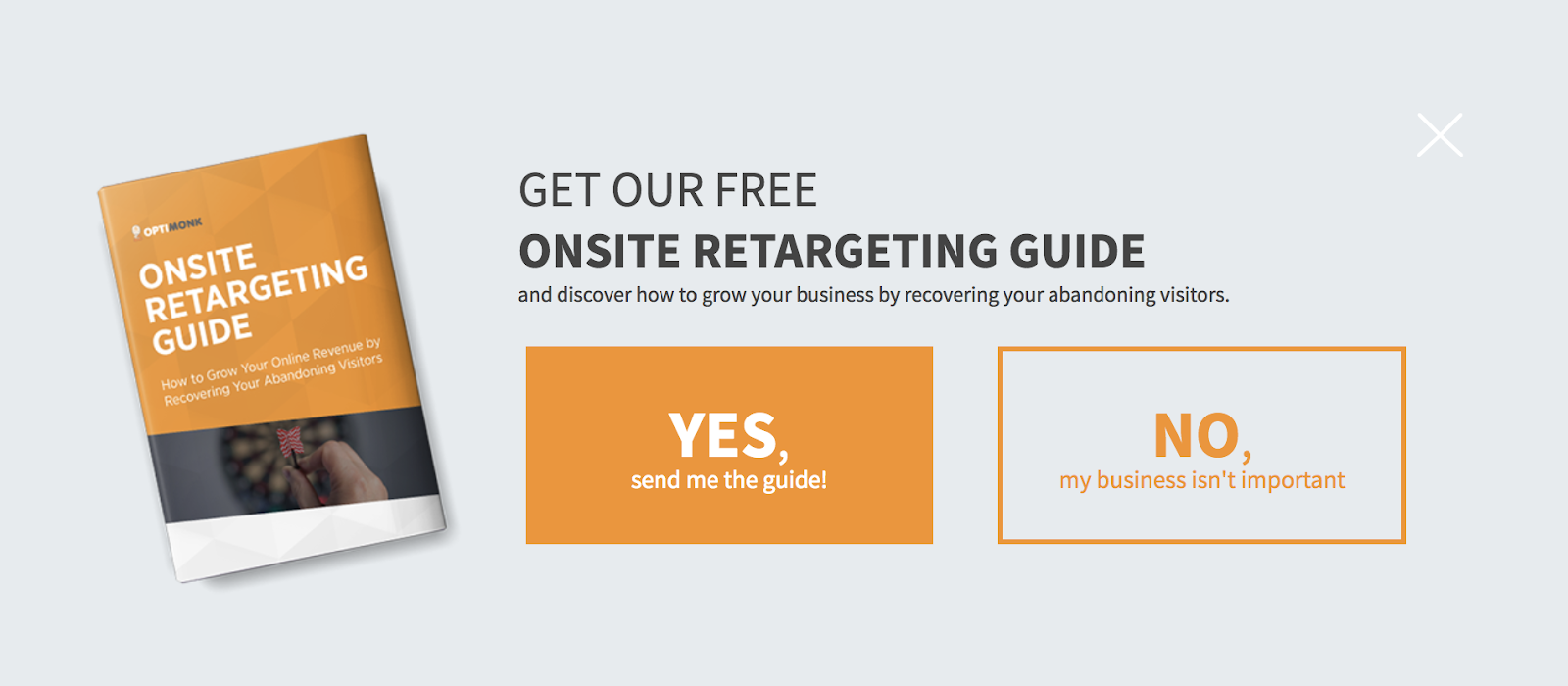
I was all set to click “No” without another thought when I read the “my business isn’t important” part. It gave me pause, made me laugh, and, most importantly, made me reconsider my almost immediate decision to exit the offer.
4. Try a scroll box.
Timing is everything. Your call-to-action works best if you catch visitors when they are, in fact, ready to take action.
Figuring out when your visitor is ready to convert depends on your website viewers’ behavior, so you’ll want to conduct A/B testing to determine where you need to place your CTA. Does it work best towards the bottom of a blog page, when it slides out to the right, or does it get higher conversions at the beginning of the page, sliding out from the left?
Ultimately, it will vary depending on your page’s content and your viewers, but a scroll box is a subtle and useful option to help you catch your viewers when they’re most ready to convert.
5. Describe value in your CTA.
We’ve talked a lot about different formatting you might use in your CTA’s (including pop-up ads or personalized offers embedded in blog posts), but what about the language in the CTA itself? You can rely on more than humor and sarcasm to get clicks.
To optimize sign-ups, ironically, you don’t want to use the words “sign up.” Who wants to “sign up” or “subscribe” to more junk emails? Instead, you want to outline the value you can offer upfront, using language like, “Download,” “Featured”, “Exclusive,” “Access.”
For instance, you might write, “Download our exclusive e-book now,” and include an email subscription form, or, you might say, “Access all our exclusive offers.” Both of these CTAs make clear the value you’ll gain from providing your email address.
Your web viewers need to hear how your emails can offer unique and exclusive content that isn’t already available on your website. They want to believe your company is offering something special via email, or what’s the point?
6. Offer Incentives
Sometimes folks need a bit of persuasion to join your list, especially if they’re new to your brand. Offering incentives can really push visitors to sign up by offering them something in exchange.
This could take the form of a one-time discount, free shipping, or another exclusive offer of your choice. Whatever you choose, it should be time-sensitive and conditional so that visitors are encouraged to sign up right away.
7. Use a Referral Program
Word of mouth is not only a great promoter, but it can work wonders for expanding your email list. This strategy leverages your existing subscribers and their network — encouraging them to share your offers with their family, friends, and colleagues.
For this strategy to achieve its full potential you’ll need to offer your existing subscribers something in exchange for their assistance. This could be a discount or other exclusive offer. In the example above from Fitness company Onnit, customers get $20 for each person they refer. That’s a pretty sweet deal.
8. Ask Visitors to Opt-In At Checkout
This is a simple strategy that I’m sure we’re all familiar with. You’re shopping online, find something you like and head to checkout to purchase. After you’ve entered all of your contact and payment information, there’s often a small checkbox right above the submit button that asks if you’d like to opt-in for emails.
You can easily recreate this in your checkout process, with a transparent opt in request at checkout. Remember it’s better to get signups the honest way rather than tricking visitors into handing over their information.
9. Gamify Signups
This may sound silly, but it works. Gamification can be a powerful tool in your marketing tool kit when used effectively. The good news is they don’t have to be complicated to boost your signups.
For example, if you’re an online retailer, you could use a spin the wheel type game (pictured above) where based on what they land on, they could “win” something. This could be a small discount, free shipping, or additional merchandise.
10. Pitch your email newsletter on your social media accounts and email signature.
You might not have a long list of email subscribers, but that doesn’t mean you don’t have a network. If you have a following on Twitter, a fan base on Facebook, or businesses you communicate with via email, why not use those firm and loyal connections to build an email list?
You might try pitching an email newsletter on your business’s Facebook, Twitter, or LinkedIn accounts. The people who follow you on those sites already know they like you, but they aren’t necessarily the same people who receive your newsletter. Give them the option.
If you’re uncomfortable pitching your email newsletter on social media, or if you don’t have a large following on any of your accounts, you could also include a link in your email signature — that link could go directly to your email newsletter, or it could be a link to a blog post or landing page with email subscription CTA’s.
You communicate daily with a diverse group of people via email, and when they get value from your personal emails, they might want the option to click a link and explore your company in more depth.
11. Create more landing pages.
HubSpot conducted research and found companies see a 55% increase in leads when they increased the number of landing pages from 10 to 15.
It makes sense: individual and personalized landing pages allow you to appeal to a wider demographic. Every person who visits your site needs something different, so the more landing pages you can create to answer each person’s individual concerns, the more sign-ups you’ll gain.
It’s like a restaurant menu. The more you can offer to cater to specific demographics, the more customers you’ll bring in. Someone could be looking for the best gluten-free pizza, while someone else might just want some good sushi.
With all of this information under our belt, it’s time to get started building that list. Luckily there are tools that can help you quickly do this.
Best Email List Builders
Now that we’ve discussed the most effective ways to grow your email list, here are a few tools that can help with the process. As mentioned previously, these tools should only be used to build a list of subscribers who have consented to receive email from you.
1. HubSpot’s Email Tool
Best for: Crafting email templates, designing landing pages and CTAs, and managing the customer lifecycle.
You’ll be happy to know there are solutions for growing your email list without breaking the bank. HubSpot offers both paid and freemium versions of its email tools to help you get started quickly.
Additional Marketing Hub capabilities include:
- Landing page creation
- Pop-up and stand-alone CTA form templates
- All-in-one solution
With HubSpot, you can boost your open and click-through rates, tailor emails to recipients, and segment your list without design or tech help. It’s easy to use, intuitive design will have you mastering email lists and campaigns like a pro.
2. Mailchimp
Best for: Designing marketing campaigns for email and landing pages that convert.
Mailchimp is another option on the market that offers email tools that range from free to paid enterprise level. This tool comes with readymade email templates, scheduling tools, and email automation options.
Its premium offerings will help you focus on and extract the most value out of your most loyal subscribers.
3. Constant Contact
Best for: General email management and building lead generation landing pages.
Constant Contact is known as an all-in-one digital marketing platform, but it does offer a decent selection of email tools that can help your campaigns stand out and get more signups. This paid service allows users to quickly drag and drop selected images and template features into custom emails, run ahead full speed with readymade email templates, send automated welcome and abandoned cart emails, and analyze results with email tracking.
4. Get Response
Best for: Performing segmentation based on user behavior.
Get Response comes with what you’d expect from email marketing software with the added bonus of lead scoring and landing pages built into the platform. However, this platform is not as user-friendly as the others on this list and will require a bit of a learning curve to take advantage of all the software has to offer.
Features include:
- Contact management
- Automation and scheduling
- Industry-specific templates
- Reporting
- Landing Pages and Lead Scoring
These advanced features do come at a premium, so if you’re looking to dive deep into segmentation you’ll need to upgrade from the free version.
5. Optimonk
Best for: Growing email, messenger, and SMS signups.
If you’re looking to upgrade your current marketing tactics for a more personal approach that gets leads, look no further than Optimonk. This platform has several integrations, including HubSpot, so chances are it will work with your existing CRM.
One of the standout features of this tool is its subscriber recognition tool which allows you to target pop-ups only for visitors that haven’t subscribed yet.
Features include:
- Subscriber recognition
- A/B testing
- Optimized for mobile
- CTA and email templates
Best of all they offer a free for forever option so you can build your list on a budget.
More Value, More Sign-Ups
When I think about the brands I like best, like J. Crew, Spotify, and SoulCycle, I know I’m not a loyal brand advocate because of their products alone.
I subscribe to J. Crew’s email list to get their “Flash Sale: Midnight” offers. I subscribe to Spotify’s newsletter to receive special promotions. And I subscribe to SoulCycle’s emails to hear about unique classes happening near me.
In short, I subscribe to their emails to get value.
If you’re starting from zero, building an impressive email list can feel like an impossible feat. With the strategies above, you too can cultivate a loyal email subscriber base by providing value — using email to attract better long-term customers.
Editor’s note: This article was originally published in November 2020 and has been updated for comprehensiveness.
![]()

